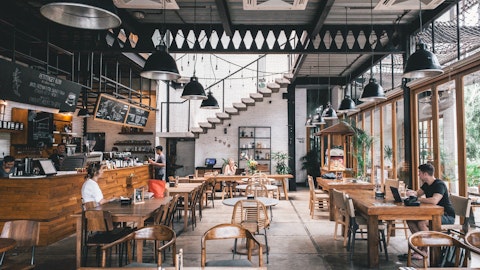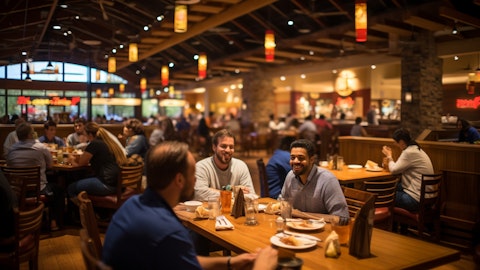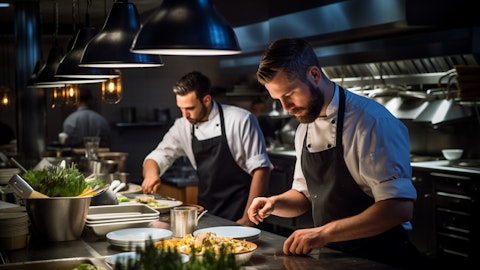Michael Bailen: Yes. Hey, Lauren, it’s Michael. Thanks for the question. You are right that those, even though we did been getting some leverage overall on that line, the underlying pressure has remained. And there are a lot of inflationary items in there, a lot of services in there, but your repair and maintenance cost is a big one on top of the general liability insurance costs, even absent some of the reserve adjustments we’ve had. So moving into 2024, I do think that on a dollars per store week, you will continue to see an increase, but it should not be at the rate that we have seen. You probably start a little bit higher in Q1, but mid-single-digit growth in those dollars per store week and then maybe coming down a little bit from that as you move through the year. That’s obviously without knowing what other kinds of reserve adjustments we may have or not have. But with what we know right now, that would be my expectation.
Lauren Silberman: Great. Very helpful. On this could go side, you saw sales per week accelerate, it looks like, throughout the year in terms of growth. Can you just provide a little bit more color on what you’re seeing on that to-go side and why you’ve seen, I guess, positive growth at least over the last three quarters now?
Jerry Morgan: Yes, I’ll start off. I just really believe that it’s our ability to execute full dining rooms and continue to keep the level of service through our to-go experience. So I think as our operators have gotten used to that volume at the high level that we are at, it has allowed us to continue to take more orders and be more available to our guests.
Chris Monroe: Yes, this is Chris. I’ll just add on. I mean, and I know you watch us every quarter, but you saw that, sort of spiked during the pandemic, then it began to come down over time, and now it is kind of coming back up again. So this is just to Jerry’s point, our folks know how to execute it, and it’s definitely a popular thing for our guests. So we’re looking forward to continuing to see that do well over time.
Lauren Silberman: Great. And just last one from me. Can you just clarify? And I appreciate the color and all the quarter-to-date, what you’re running in terms of comp as the weather passed, just to clarify.
Michael Bailen: Sure. Lauren, it’s Michael. So within that 50 days, I guess, I can tell you our January comp was 4.2%. And then the last three weeks plus a day was a little over 10%.
Lauren Silberman: Appreciate all the color.
Operator: Your next question comes from the line of Andy Barish from Jefferies. Your line is open.
Andy Barish: Hey, guys, most of my stuff has been asked. Could you quantify in the 4Q sort of the holiday benefit of the Christmas shift. And then the Lenten season is upon us and started a week earlier for 1Q. Any commentary around that for the rest of the quarter or is it kind of minor?
Jerry Morgan: Hey, Andy. How are you doing, bud? Listen, the first quarter, obviously, we just had Valentine’s Day yesterday, which gives us a great indication that we’re off and running strong and solid. So that’s hard to – all the other things that you asked about, I do know we have some promotional stuff going on at Jaggers. But I think right now, without the weather, the momentum is very solid into the first quarter.
Michael Bailen: And, Andy, it’s Michael. I don’t know if I have any numbers at my fingertips regarding the benefits around the holidays. But we definitely saw some benefit in that timeframe. But I’m not going to be able to put a number on that right now. But again, the numbers we’ve been putting up go beyond just a couple of days with a calendar shift. We’ve saw strain for quite a while.
Andy Barish: Understood. And then just circling back on the CapEx with the 200 digital kitchen conversions coming in, but total CapEx staying the same. What’s the offset there? Were there some idiosyncratic things that kind of hit last year? Or how should we think about that staying flat, although clearly spending some more capital on the KDS.
Michael Bailen: Yes. Andy, without getting too much into the details, it’s fair to say that our initial estimate that we put out there gave us some room – some wiggle room for other projects and things to come in there. And the acceleration of the digital kitchens filled some of that space. So again, we left ourselves some room for that. So it was not that we did this and had to replace it with – take something else out.
Chris Monroe: Yes, I’ll just – Andy, it’s Chris, I’ll just add into that. It’s about $45,000 a store to put the KDS in. And so you’re talking about roughly $9 million. And on that big of a budget, we can find a way to get it in there.
Andy Barish: Great. Appreciate the detail. Thank you.
Jerry Morgan: Thank you.
Operator: Your next question comes from the line of Chris O’Cull from Stifel. Your line is open.
Chris O’Cull: Hey, thanks. Good afternoon, guys. Jerry, are you seeing any signs that are growing that a number of your restaurants may be getting closer to capacity during peak hours? I’m just wondering if you’re seeing a need for additional bump outs or maybe any other approach that could increase sales headroom.
Jerry Morgan: Yes. Chris, thanks for the – I think the bump outs, and we’re doing cooler expansions, which really – that’s part of what the costs are, is giving these folks that are really serving a lot of guests is really more storage in the back to be able to get more food in their building. The upside to even at our elevated average unit volume at over 7.5 million, we’ve got a large group of restaurants that are doing significantly more than that. And so, as I’ve said in the past, they’re the ones leading the way that show us that even our average unit volumes can increase year-after-year if we continue to execute and do the things that our operators need to be able to get more people through their building. And there’s definitely a demand there. We just got to continue to execute more people, more product and we’ll be just fine.
Michael Bailen: And Chris, this is Michael. I just want to add on to what Jerry said, which I think is quite impressive. Those highest volume restaurants, the ones that are above average or well above average, continue to comp at or – at least at the average, if not better than average that certainly happened throughout 2023. So we haven’t seen those busiest restaurants come up against a wall as far as growth. So that gives us quite a bit of confidence for even the room that our average stores have for future growth.
Chris O’Cull: That’s impressive. And then can you provide some additional color around what unit economics you’re targeting at Jaggers? And then maybe how many development commitments that you have right now for Jaggers?
Chris Monroe: Yes, go ahead, Michael.
Michael Bailen: Yes, Chris, it’s Michael again. I would say it’s a little early for us to get into specifics on returns. Clearly we have a couple franchisees already who have opened stores and will be opening more stores. So I don’t want to put words in their mouth, but I would say they are pleased with what they are seeing. And there are continued conversations with future partners as well. So not going to get into returns, either on the company side or the franchise side, but we are very pleased with what we are seeing and what we believe Jaggers can do going forward.
Chris O’Cull: Great. Thanks, guys.
Jerry Morgan: Thank you.
Michael Bailen: Thanks, Chris.
Operator: Your next question comes from the line of Andrew Strelzik from BMO. Your line is open.
Andrew Strelzik: Hey, good afternoon. Thanks for taking the questions. I was hoping you could start maybe by giving some color on Bubba’s. I know you’ve done a lot of work on the brand over the last two years or so. So where are you seeing progress or other areas that need more work opportunities? Thoughts around where Bubba’s is today would be great.
Jerry Morgan: Yeah. Thank you, Andrew. I feel really good about Bubba’s. We’ve put a lot of investment in the last couple of years, not only on the people – getting the right people, the leaders, the support all the way around it. We’ve done some – what I think are really solid structural parts of the building to keep the cost down, and we see our sales growing. So all of the indicators are that people are loving the food with the burgers and the pizzas and the energy that we have with our rock ‘n’ roll. But I think the biggest thing is about having leadership, having consistency and ability to execute, and people identifying who Bubba’s 33 is. So all indicators are very positive and we’re very happy with the continued progress that Bubba’s is making.
Andrew Strelzik: That’s great to hear. And then just following up on some of the commodity inflation or food inflation outlook, you noted the kind of more modest increases in the first half of the year and then a step up in the back half. Can you be a little more specific kind of either front half, back half or by quarter kind of how you’re expecting that to progress?
Michael Bailen: Yes. Andrew, it’s Michael. I’d say Q1 is definitely kind of our expectation to be at the low point where maybe you’re in the 2% to 3% inflation range, and then it grows from there. And I don’t know necessarily, I have – that the Q2, three and four that dramatically different than each other. It is a stair step up, certainly from probably Q2 into the back half, but that Q1 is really the one that stands out as being a little bit lower.
Andrew Strelzik: Okay. And maybe if I could just squeeze one more in, a question on buybacks and your appetite there. You noted paying off the last bit of the debt there. And I know the CapEx is going to be up, but I’m just curious, your appetite for share repurchases at this point for 2024. Thanks.


